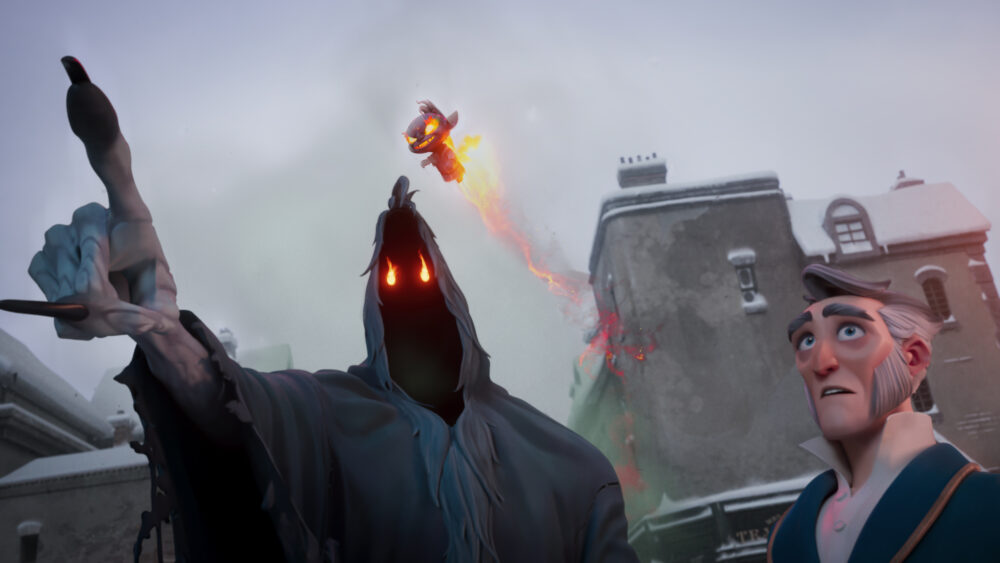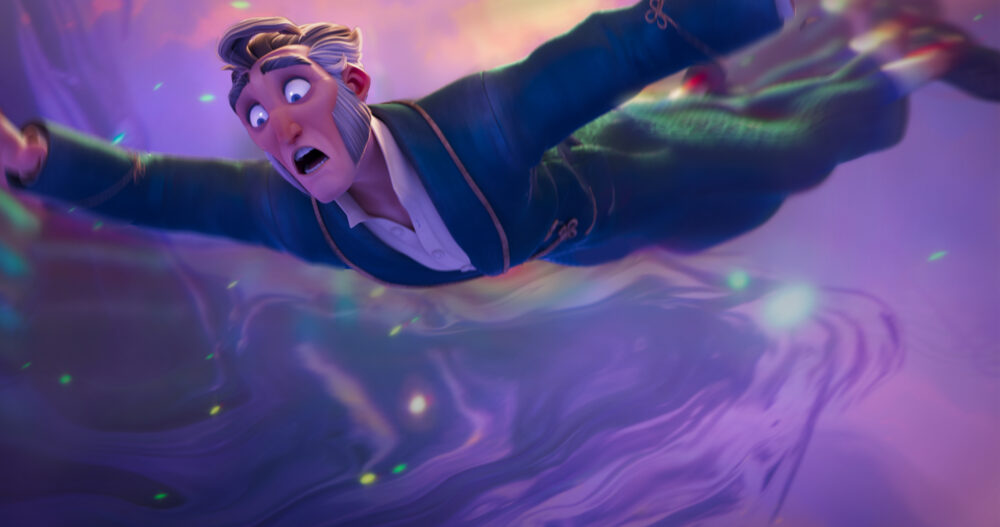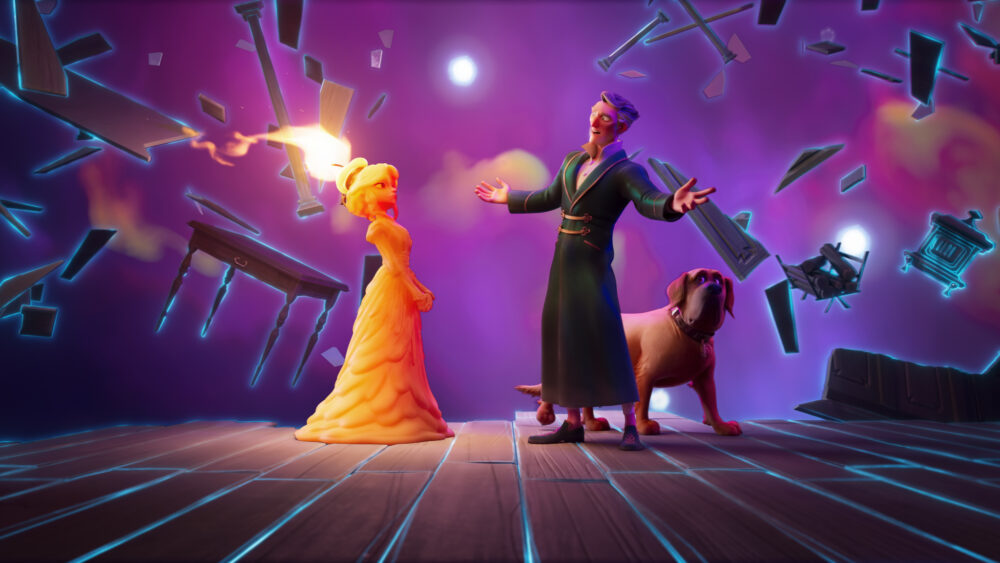***This article originally appeared in the January ’23 issue of Animation Magazine (No. 326)***
Charles Dickens’ 1843 novella A Christmas Carol is by far one of the most popular holiday tales of all time, inspiring close to 100 live-action and animated adaptations throughout the years. This month, audiences are treated to a new animated version of the classic directed by animation veteran Stephen Donnelly, titled Scrooge: A Christmas Carol.
The latest take on the tale is produced by U.K.-based Timeless Films (Rock Dog, Postman Pat: The Movie, Pets United, Extinct) and features Luke Evans in the title role, as well as Olivia Colman, Jessie Buckley and Jonathan Pryce, and songs by the late Leslie Bricusse, a two-time Academy Award winner who is known for his work on Willy Wonka and the Chocolate Factory and Superman. The production also offers surprising psychedelic visuals and inspired time-traveling sequences that offer a new spin on the tale of a miserable penny-pincher who learns to mend his ways during the holiday season.

Something Classic, Something New
Much of the production of the movie took place during the pandemic lockdowns, so Donnelly and producer Ralph Kamp, CEO of Timeless Films, knew they had some challenges ahead when they started the project. The crew focused on making their version of the story something that retained the essence of the classic, while giving viewers something new at the same time.

“I think every part of a production should be driven by the themes and content of the story, as well as what your underlying message is,” says Donnelly. “From design to final moving image, if something doesn’t help tell the story or enhance the thematic resonance for an audience, it shouldn’t be in there. Especially on tight schedules, holding on to that mantra helps clarify your thinking and motivate choices.”
Donnelly points out that the limitations helped inspire new ways of approaching the story. “The Christmas deadline wasn’t going anywhere as well as the content and message,” he notes. “Specifically, Dickens’ caricatured London and Scrooge’s journey from misanthrope to humanitarian — that whole world and Scrooge’s journey through it was the core we built everything else on,” says the director. “I worked with our brilliant animation supervisor, Simon Allen, to design the distinctive way our characters should move. We started with Scrooge — he begins the movie with very guarded but imposing body language and posture, eventually opening up and embracing the world. As I said, every decision was made to relentlessly underline Scrooge’s change. We arrived at a more classical but very punchy and clean style of movement, with minimal extraneous detail. It gave everything a sense of clipped Victorian elegance, which didn’t get in the way of performance and story.”
Donnelly and his crew planned to do a full research tour of what still remains of Victorian London, but COVID hit just as they were about to get started. So, they switched plans and consulted experts in the era to make sure they were capturing the essential essence of the time. Once the research was done, Donnelly chose a look more in line with magical realism or even a fairy tale, because he wanted to distinguish this film from some of the black and white costume dramas we’ve all seen play during the holidays. Instead, they were visually inspired by things like William Logsdail’s paintings, especially his famous 1888 work, St Martin-in-the-Fields.

“This painterly approach extended beyond the world of our story to the characters themselves,” says Donnelly. “The very subtle, visible brush strokes on our characters were heavily influenced by John Singer Sargent and John Everett Millais. The lustrous, glowing lanterns washing skin with tinted light in Sargent’s Carnation, Lily, Lily, Rose was a big influence on our lighting style. Our art director François Moret worked with our brilliant color key team to bring that same dreamy, luminous magic to the world of our movie.”
Donnelly points out that not every visual influence was British. He explains, “We cheated a bit by drawing from the contouring of American illustration masters J.C. Leyendecker and Norman Rockwell for some of our more grounded, refined characters, but mixed that with the very European caricature of George Cruikshank and Honoré Daumier for the likes of Mr. Fezziwig. On top of that, we sprinkled some Ronald Searle, who did a spectacular set of illustrations for the original 1970 movie’s opening titles. Gary Dunn and Nick Kole did a tremendous job of assimilating these seemingly disparate references into a style that feels fresh and unique to this adaptation. I tend not to reference animated movies when creating a look in my work, because I think animation needs to cannibalize itself less in order to stay truly fresh.”

Donnelly and Kamp were also thrilled to be able to work with the late composer Leslie Bricusse on this project. The songs written for this film were among the last he contributed to a film.
“Leslie was so enjoyable to work with and was my producing partner during development and early production, before he became ill and sadly passed away before we finished the film,” says Kamp. “I was very happy to be able to share with him some early finished sequences from the film, so he saw something of what we were creating and genuinely loved seeing his songs come alive in this animated form. One of the last songs Leslie wrote was the wonderful new song ‘I Love Christmas’ that opens the film. Stephen and I had discussed how we wanted a real ‘Happy Christmas’ feeling to the opening, before Scrooge arrives to change the mood for the audience. Leslie seemed to instinctively know what we needed and, set against Stephen’s amazing vision, the opening really pulls the viewer in immediately.”
Their voice cast brings together top talent as well, with Luke Evans in the role of Scrooge, Jessie Buckley in the key part of Isabel Fezziwig and Olivia Coleman as the Ghost of Christmas Past. “There aren’t many actors who can carry the weight of this particular Scrooge’s emotional arc and hit the notes some of Leslie’s songs require: Luke Evans is at the very top of that list,” says Donnelly. “He is also around the same age as our Scrooge, who is significantly younger than in some of the famous adaptations. You can hear in his voice that he still has some life left to live when his transformation is complete. His pleading by the graveside in the Future sequence is some of the best voice work I’ve heard in animation.”

Exceptional Voices
The director says he has been a longtime fan of Olivia Colman, going back to her days in the sitcom Peep Show. “The slightly unhinged and Oscar-winning energy she displayed in The Favourite was a big touchstone for me while writing the Past character,” he notes. “She was basically just perfect for this role and such fun to work with, not even blinking when I asked her to bark one of her lines rather than speak it. Unfortunately, the dog scene was cut! Jessie Buckley has only a handful of spoken lines, but everything she says is so moving and her duets with Luke are the emotional turning point of the entire movie.”
With a distinctive cast, memorable songs and the kind of imaginative, risk-taking imagery that sets a story apart from the rest, Donnelly still has his eye on achieving something timeless for his take on a timeless story.

“Beyond the emotional and musical side, I think there’s a particularly bizarre brand of spectacle in this version that I’ve not seen elsewhere,” says Donnelly. “It takes you on a wild ride from the moment Scrooge encounters Marley, spitting our antihero across space and time, accompanied by visually spectacular supernatural sidekicks. While editing the movie we would often pause on a frame that I think Dickens and Leslie would be hard pushed to identify as a Victorian morality tale.
“We definitely swung for the fences on so many of the sequences. I hope that kids who are so familiar with the impressive visual effects of modern blockbusters will take our epic Christmas Carol to heart and see it as their own personal, definitive version.”
Scrooge: A Christmas Carol premieres on Netflix on December 2.









 Win 'The Art of DreamWorks Dog Man'!
Win 'The Art of DreamWorks Dog Man'! 

